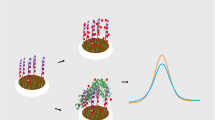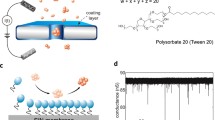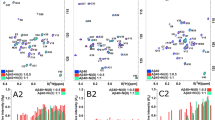Abstract
One of the prevailing paradigms regarding the onset of Alzheimer’s disease endows metal ions with key roles in certain steps of the amyloid-β (Aβ) peptide aggregation cascade, through peptide conformational changes induced by metal binding. Herein, we focused on the truncated, more soluble Aβ1–16 peptide fragment from the human Aβ1–40, and demonstrated the utility of a sensing element based on the α-hemolysin (α-HL) protein to examine and compare at single-molecule level the interactions between such peptides and various metals. By using the same approach, we quantified Cu2+ and Zn2+ binding affinities to the Aβ1–16 fragment, whereas the statistical analysis of blockages induced by a single Aβ1–16 peptide on the current flow through an open α-HL pore show that the metal propensity to interacting with the peptide and entailing conformational changes obey the following order: Cu2+ > Zn2+ > Fe3+ > Al3+.




Similar content being viewed by others
References
Ali FE, Separovic F, Barrow CJ, Yao S, Barnham KJ (2006) Copper and zinc mediated oligomerisation of Aß peptides. Int J Pept Res Ther 12:153–164
Antzutkin ON (2004) Amyloidosis of Alzheimer’s A peptides : solid-state nuclear magnetic resonance, electron paramagnetic resonance, transmission electron microscopy, scanning transmission electron microscopy and atomic force microscopy studies. Magn Reson Chem 42:231–246
Asandei A, Apetrei A, Park Y, Hahm KS, Luchian T (2011) Investigation of single-molecule kinetics mediated by weak hydrogen-bonds within a biological nanopore. Langmuir 27:19–24
Asandei A, Schiopu I, Iftemi S, Mereuta L, Luchian T (2013) Investigation of Cu2+ binding to human and rat amyloid fragments Aβ (1–16) with a protein nanopore. Langmuir 29(50):15634–15642
Atwood CS, Scarpa RC, Huang X, Moir RD, Jones WD, Fairlie DP, Tanzi RE, Bush AI (2000) Characterization of copper interactions with alzheimer amyloid beta peptides: identification of an attomolar-affinity copper binding site on amyloid beta 1–42. J Neurochem 75:1219–1233
Baran C, Smith GS, Bamm VV, Harauz G, Lee JS (2010) Divalent cations induce a compaction of intrinsically disordered myelin basic protein. Biochem Biophys Res Commun 391:224–229
Bayley H, Luchian T, Shin SH, Steffensen M (2008) Single-molecule covalent chemistry in a protein nanoreactor. In: Rigler R, Vogel H (eds) Single molecules and nanotechnology. Springer Series in Biophysics, Heidelberg, pp 251–277
Chen YR, Huang HB, Chyan CL, Shiao MS, Lin TH, Chen YC (2006) The effect of Abeta conformation on the metal affinity and aggregation mechanism studied by circular dichroism spectroscopy. J Biochem 139:733–740
Chen WT, Liao YH, Yu HM, Cheng IH, Chen YR (2011) Distinct Effects of Zn2+, Cu2+, Fe3+, and Al3+ on Amyloid-β stability, oligomerization, and aggregation. Amyloid-β destabilization promotes annular protofibril formation. J Biol Chem 286:9646–9656
Curtain CC, Ali F, Volitakis I, Cherny RA, Norton RS, Beyreuther K, Barrow CJ, Masters CL, Bush AI, Barnham KJ (2001) Alzheimer’s disease amyloid-beta binds copper and zinc to generate an allosterically ordered membrane-penetrating structure containing superoxide dismutase-like subunits. J Biol Chem 276:20466–20473
Danielsson J, Pierattelli R, Banci L, Gräslund A (2007) A high-resolution NMR studies of the zinc-binding site of the Alzheimer’s amyloid beta-peptide. FEBS J 274:46–59
Drew SC, Barnham KJ (2011) The heterogeneous nature of Cu2+ interactions with Alzheimer’s amyloid-β peptide. Acc Chem Res 44:1146–1155
Fändrich M (2012) Oligomeric Intermediates in Amyloid formation: structure determination and mechanisms of toxicity. J Mol Biol 421(4–5):427–440
Gu LQ, Shim JW (2010) Single molecule sensing by nanopores and nanopore devices. Analyst 135:441–451
Gu LQ, Braha O, Conlan S, Cheley S, Bayley H (1999) Stochastic sensing of organic analytes by a pore-forming protein containing a molecular adapter. Nature 398:686–690
Hong L, Carducci TM, Bush WD, Dudzik CG, Millhauser GL, Simon JD (2010) Quantification of the binding properties of Cu2+ to the amyloid-beta peptide: coordination spheres for human and rat peptides and implication on Cu2+-induced aggregation. J Phys Chem B 114:11261–11271
Hung YH, Bush AI, Cherny RA (2010) Copper in the brain and Alzheimer’s disease. J Biol Inorg Chem 15:61–76
Istrate AN, Tsvetkov PO, Mantsyzov AB, Kulikova AA, Kozin SA, Makarov AA, Polshakov VI (2012) NMR solution structure of rat Aβ(1–16): toward understanding the mechanism of rats’ resistance to Alzheimer’s disease. Biophys J 102:136–143
Karr JW, Akintoye H, Kaupp LJ, Szalai VA (2005) N-terminal deletions modify the Cu2+ binding site in amyloid-beta. Biochemistry 44:5478–5487
Kasianowicz JJ, Brandin E, Branton D, Deamer DW (1996) Characterization of individual polynucleotide molecules using a membrane channel. Proc Natl Acad Sci USA 93:13770–13773
Kasianowicz JJ, Robertson JWF, Chan ER, Reiner JE, Stanford VM (2008) Nanoscopic Porous Sensors. Annu Rev Anal Chem 1:737–766
Leal SS, Botelho HM, Gomes CM (2012) Metal ions as modulators of protein conformation and misfolding in neurodegeneration. Coord Chem Rev 256:2253–2270
Majd S, Yusko EC, Billeh YN, Macrae MX, Yang J, Mayer M (2010) Applications of biological pores in nanomedicine, sensing, and nanoelectronics. Curr Opin Biotechnol 21:439–476
Menestrina G (1986) Ionic channels formed by Staphylococcus aureus Alpha-Toxin: voltage-dependent inhibition by divalent and trivalent cations. J Membr Biol 90:177–190
Mereuta L, Schiopu I, Asandei A, Park Y, Hahm KS, Luchian T (2012) Protein nanopore-based, single-molecule exploration of copper binding to an antimicrobial-derived, histidine-containing chimera peptide. Langmuir 28:17079–17091
Movileanu L, Schmittschmitt J, Scholtz JM, Bayley H (2005) Interaction of peptides with a protein nanopore. Biophys J 89:1030–1045
Nair NG, Perry G, Smith MA, Reddy VP (2010) NMR studies of zinc, copper, and iron binding to histidine, the principal metal ion complexing site of amyloid-beta peptide. J Alzheimers Dis 20:57–66
Narayan P, Krishnarjuna B, Vishwanathan V, Jagadeesh DK, Babu S, Ramanathan KV, Easwaran KR, Nagendra HG, Raghothama S (2013) Does aluminium bind to histidine? An NMR investigation of amyloid β12 and amyloid β16 fragments. Chem Biol Drug Des 82:48–59
Pagel K, Seri T, von Berlepsch H, Griebel J, Kirmse R, Böttcher C, Koksch B (2008) How metal ions affect amyloid formation: Cu2+- and Zn2+-sensitive peptides. ChemBioChem 9:531–536
Sacco C, Skowronsky RA, Gade S, Kenney JM, Spuches AM (2012) Calorimetric investigation of copper(II) binding to Aβ peptides: thermodynamics of coordination plasticity. J Biol Inorg Chem 17:531–541
Smith DP, Smith DG, Curtain CC, Boas JF, Pilbrow JR, Ciccotosto GD, Lau TL, Tew DJ, Perez K, Wade JD, Bush AI, Drew SC, Separovic F, Masters CL, Cappai R, Barnham KJ (2006) Copper-mediated amyloid-beta toxicity is associated with an intermolecular histidine bridge. J Biol Chem 281:15145–15154
Sokołowska M, Bal W (2005) Cu(II) complexation by “non-coordinating”N-2-hydroxyethylpiperazine-N0-2- ethanesulfonic acid(HEPES buffer). J Inorg Biochem 99:1653–1660
Song LZ, Hobaugh MR, Shustak C, Cheley S, Bayley H, Gouaux JE (1996) Structure of staphylococcal alpha-hemolysin, a heptameric transmembrane pore. Science 274:1859–1866
Stefureac R, Waldner L, Howard P, Lee JS (2008) Nanopore analysis of a small 86-residue protein. Small 4:59–63
Stellato F, Menestrina G, Serra MD, Potrich C, Tomazzolli R, Meyer-Klaucke W, Morante S (2006) Metal binding in amyloid β-peptides shows intra- and inter-peptide coordination modes. Eur Biophys J 35:340–351
Syme CD, Nadal RC, Rigby SE, Viles JH (2004) Copper binding to the amyloid-beta (Abeta) peptide associated with Alzheimer’s disease: folding, coordination geometry, pH dependence, stoichiometry, and affinity of Abeta-(1-28): insights from a range of complementary spectroscopic techniques. J Biol Chem 279:18169–18177
Tougu V, Karafin A, Palumaa P (2008) Binding of zinc(II) and copper(II) to the full-length Alzheimer’s amyloid-beta peptide. J Neurochem 104:1249–1259
Tsvetkov PO, Kulikova AA, Golovin AV, Tkachev YV, Archakov AI, Kozin SA, Makarov AA (2010) Minimal Zn(2+) binding site of amyloid-β. Biophys J 99:L84–L86
Valensin D, Migliorini C, Valensin G, Gaggelli E, La Penna G, Kozlowski H, Gabbiani C, Messori L (2011) Exploring the reactions of β-amyloid (Aβ) peptide 1-28 with Al(III) and Fe(III) ions. Inorg Chem 50:6865–6867
Vestergaard M, Kerman K, Saito M, Nagatani N, Takamura Y, Tamiya E (2005) A rapid label-free electrochemical detection and kinetic study of Alzheimer’s amyloid beta aggregation. J Am Chem Soc 127:11892–11893
Wang HY, Ying YL, Li Y, Kraatz HB, Long YT (2011) Nanopore analysis of β-amyloid peptide aggregation transition induced by small molecules. Anal Chem 83:1746–1752
Wang G, Wang L, Han Y, Zhou S, Guan X (2014) Nanopore detection of copper ions using a polyhistidine probe. Biosens Bioelectron 53(15):453–458
Wärmländer S, Tiiman A, Abelein A, Luo J, Jarvet J, Söderberg KL, Danielsson J, Gräslund A (2013) Biophysical studies of the amyloid β-peptide: interactions with metal ions and small molecules. ChemBioChem 14:1692–1704
Zirah S, Kozin SA, Mazur AK, Blond A, Cheminant M, Ségalas-Milazzo I, Debey P, Rebuffat S (2006) Structural changes of region 1–16 of the Alzheimer disease amyloid beta-peptide upon zinc binding and in vitro aging. J Biol Chem 281:2151–2161
Acknowledgments
We acknowledge the financial support offered by grants PN-II-ID-PCCE-2011-2-0027, PN-II-PT-PCCA-2011-3.1-0595 and PN-II-PT-PCCA-2011-3.1-0402.
Author information
Authors and Affiliations
Corresponding author
Additional information
Alina Asandei and Sorana Iftemi have contributed equally to this work.
Electronic supplementary material
Below is the link to the electronic supplementary material.
Rights and permissions
About this article
Cite this article
Asandei, A., Iftemi, S., Mereuta, L. et al. Probing of Various Physiologically Relevant Metals: Amyloid-β Peptide Interactions with a Lipid Membrane-Immobilized Protein Nanopore. J Membrane Biol 247, 523–530 (2014). https://doi.org/10.1007/s00232-014-9662-z
Received:
Accepted:
Published:
Issue Date:
DOI: https://doi.org/10.1007/s00232-014-9662-z




